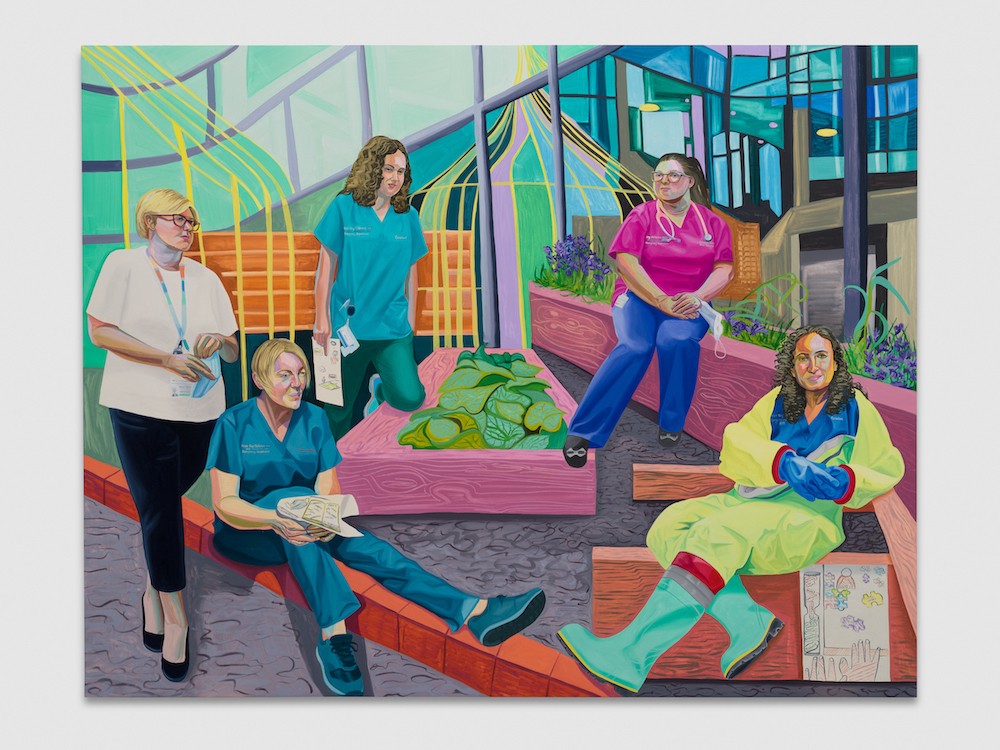Painting the NHS: A Conversation with Professor Aliza Nisenbaum on Her Latest Exhibition
Professor Tom Kalin recently sat down with Assistant Professor Aliza Nisenbaum to discuss her latest solo exhibition, Aliza Nisenbaum, on display through June 27, 2021 at Tate Liverpool. The event was the latest in Columbia University School of the Arts’ Complex Issues series.
Born in Mexico City, Nisenbaum makes portrait paintings, concretions of an exchange through time with her subjects. Collaborating with distinct communities, the artist employs the focused attention of observational painting to create the conditions for close-looking, a state drawing upon personal connection to her subjects. At the foreground of her work are distinct social groups, with subjects including undocumented immigrants, dancers, members of grassroot organizations, and subway workers. Nisenbaum engages with these groups on various levels through pedagogy, the sharing of resources, skills and, ultimately, social representation. In 2019 she completed a residency and public mural project for the Art on the Underground Commission in London. Recent solo shows include Anton Kern gallery (New York, 2019 and 2020), and the Minneapolis Institute of Art (Minneapolis, 2017).
Kalin’s acclaimed films include Swoon and Savage Grace. Kalin’s films as a producer include I Shot Andy Warhol and Go Fish. He recently directed the first episode of Pride, a six part documentary series for the FX Networks and produced by Killer Films and Refinery29. The series conveys the history and diversity of LGBTQ civil rights in America. Kalin’s episode, which concerns the 1950s, will air later in 2021. He is also a founding member of the AIDS activist collectives ACT UP and Gran Fury.
Nisenbaum’s current exhibition at Tate Liverpool features a series of new portraits of healthcare workers in the UK. When Nisenbaum and her team initially put out open calls to different hospitals in Liverpool, the response rate was robust to say the least. Among the submissions was an entire team from Alder Hey Children’s Hospital who wanted to be represented in Nisenbaum’s work. The team is featured together in one of the exhibition’s two large-scale group portraits. The exhibition also includes eleven individual portraits, as well as three films, one of which documents Nisenbaum’s creation of the NHS paintings.
Nisenbaum played a short excerpt from the “making of'' documentary for the audience to allow them to hear her subjects’ stories in their own voices. Among them is Lalith Wijedoru, a Consultant Physician at Alder Hey Children’s Hospital, who speaks about his experiences in the short video: “For the first time in my life, I had a four-month period of not being able to touch anybody. I used to lie on the slate tiles in my kitchen, on the laminate floor in my corridor, and on different fabrics just to simulate a different sort of sensation on my skin.” Wijedoru’s story is but one among the many that reflects the specific impact that the pandemic has had on healthcare workers’ lives. Central to Nisenbaum’s project was thinking about how to commemorate and honor healthcare workers, who continue to work extraordinary hours under incredibly difficult conditions.
The restrictions of the pandemic demanded a different approach to the painting process for Nisenbaum, who typically paints her subjects from life over the course of multiple lengthy sessions. “As I was starting to think about this project,” Nisenbaum said, “I was supposed to be on site last spring in Liverpool, and as things shifted very quickly, I ended up making a project that was done remotely between Los Angeles and Liverpool.” Instead of her typical in-person sessions, Nisenbaum met with her subjects first over Zoom and continued to converse via email and phone throughout the entire project. Nisenbaum used “these conversations to include elements of [the subjects’] personality and interests within her paintings. They are shown alongside things that have given them support and hope through this difficult time, such as pets or musical instruments.” While Nisenbaum was unable to travel to Liverpool for the opening, the Tate opened the museum for each of the subjects who were depicted in the exhibition.
Kalin asked Nisenbaum about the change from sharing an elongated, intimate amount of time with her subjects in person, to suddenly painting by herself in a studio. “It provided a very interesting different type of reflection...Calum, [one her subjects], for example, took me on a tour of his home and showed me all the watercolor artists from Scotland that he collects. I got a sense of their home settings, which I wouldn’t have had otherwise. There was a lot of back and forth with email and Zoom, and there was a lot of time to reflect. For me to go on walks and think about what flowers I wanted to send each person metaphorically through my watercolors...in some ways, I had more time to think about the compositions without having that kind of direct energy I get from people when I’m painting them from life. It’s not to be underestimated—this sense of presence.”
Watch the complete video documenting Nisenbaum’s production of the NHS portraits here. The conversation between Nisenbaum and Kalin can be viewed below.
